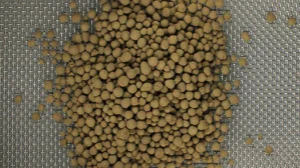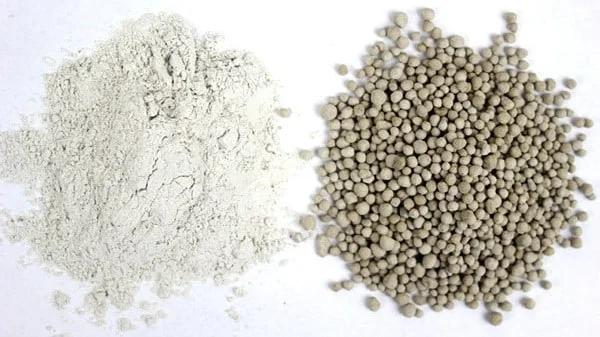
While granulating limestone has become common practice for the many advantages it can offer, the process requires careful engineering to ensure a consistently reliable, continuous operation with maximum on-size yield. A number of material characteristics come into play.
The Limestone Granulating Process
The most common setup for a limestone granulating plant utilizes a mixer and disc granulator combination, an approach that not only maximizes on-size yield, but also leaves producers with a highly refined product.
This type of setup relies on the principles of wet granulation, or agitation agglomeration, in which a liquid binder is employed, alongside a tumbling motion, to convert powders and fines into spherical granules in an effect similar to rolling a snowball.
Material Characteristics that Influence the Limestone Granulating Process
Optimal pellet formation and growth depend largely on achieving the right combination of parameters, with each material’s optimal combination varying considerably.
The following characteristics form the basis of any granulating operation, regardless of the material.
Particle Size Distribution
Particle size distribution, or PSD, is highly influential in agglomeration. The distribution of particle sizes must be narrow enough to promote a uniform product, while diverse enough to exhibit some range within the allotted window, allowing smaller particles to fill in the spaces between larger ones.
The ideal particle size distribution for a given material to properly agglomerate varies. For limestone optimal PSD tends to fall within minus 250 micron.

This illustration shows how the right PSD allows smaller particles to fill in the spaces between larger particles during pellet formation.

Raw and Pelletized Limestone
Particle Shape
Similar to particle size distribution, particle shape also has ramifications on the granulating process, primarily on how particles fit together on a micro level and more specifically, the strength of the resulting agglomerates.
Granules with a lot of void spaces due to an irregular shape will be weak, while more rounded particles fit together better to promote a stronger agglomerate.
Not surprisingly, particle shape works hand-in-hand with particle size distribution to establish the matrix of how particles fit together.
Limestone particle shape varies depending on a range of factors, including natural formation and pretreatment methods.
Moisture Content
Moisture content is highly influential in the granulating process; too little moisture and particles do not have the strength to coalesce, while too much can turn the material into a cake or slurry.
Each and every material has a precise “window” of moisture content, within which it will optimally agglomerate. For limestone, the window for optimal agglomeration tends to fall within 5% to 15%.
As with particle size distribution, the need for a precise moisture content often requires some level of pretreatment. This may be in the form of a pre-drying step, or through backmixing – a technique in which dried material is mixed in (typically using a mixer) with the raw feedstock to reduce the overall moisture content of the mixture.
Bulk Density
Limestone typically has a bulk density in the range of 60 to 80 PCF, though again, this can vary. Bulk density is important to consider, because in general, the lower the bulk density of the feedstock, the lower the throughput the system will be able to achieve.
This is because most limestone producers are looking to reach a product with a specific bulk density, with a range similar to fertilizer products. The farther away from this target the feedstock falls, the longer it will take to reach that target density.
This is one reason why producers utilizing a disc granulator alone choose to incorporate a mixer; because the mixer achieves greater density very quickly through motion, production is increased.
Limestone Composition
As we’ve already mentioned, limestone can vary significantly in the physical properties it naturally exhibits. Likewise, limestone’s chemical composition can also vary significantly from one source to the next and even within the same deposit, creating an unending matrix of potential compositions and characteristics.
The different constituents found with limestone and the quantities at which they are present can make the granulating process extremely unpredictable. It is for this reason that process development work is still widely carried out when engineering a limestone granulating line, despite the technique being so well established in the industry. Two of the most commonly occurring constituents that affect the granulating process are clay and silica.
Clay is interesting in that it can actually assist the agglomeration process; as a natural binding agent, clay present in limestone can reduce the requirement for an alternative binder, depending on the type of clay and the quantity at which it is present. If the clay content is too high, however, it can inhibit or even prevent agglomeration, as the material begins to behave like a cake or slurry.
Recycle
Recycle is the amount of over- and under-size product a process yields. While recycle is not a characteristic of limestone, it is impacted by limestone’s characteristics and worth mentioning for that reason.
Some limestone, due to its unique combination of physical and chemical properties, is easily managed during the agglomeration process. In other words, operators are able to easily control pellet formation and growth by systematically adjusting process variables. Because of this, operators are better able to control the on-size yield, equating to less recycle.
In contrast, a limestone that is difficult to manage yields a higher recycle rate. Some amount of recycle is often desirable, as it gives operators a buffer in the event of an upset and also makes startup of the process easier. Too much recycle, however, is inefficient, resulting in a high amount of material reprocessing.
Limestone Challenges
In addition to the standard parameters that influence the granulating process, limestone also exhibits a number of material characteristics that can present challenges to those looking to convert their limestone into a granular product. Limestone’s potential for wide variation, its abrasive nature, and a tendency to clump and cause buildup, reinforce the need for early test work.
Characteristics of Pelletized Limestone
By managing the aforementioned characteristics, along with production conditions, limestone producers can refine their granulating process to yield a product that meets precise specifications. Producers are frequently looking to target some combination of the following, based on handling, performance, and appearance requirements:
- Bulk density (apparent and tapped)
- Surface area to volume
- Compression
- Crush strength
- Flowability
- Green/Wet strength
- Porosity
- Attrition
- Particle size distribution (PSD)
- Moisture content
- Solubility
In fact, it is this particle engineering capability that continues to see pelletized limestone gain increased market share in the soil amendment industry and elsewhere; producers are able to hone in on particle characteristics to ensure their products meet market expectations in the form of:
- Product uniformity
- Minimal dust (attrition)
- Handling and performance characteristics
- Storage potential and shelf life
- Blending abilities
- Appearance



